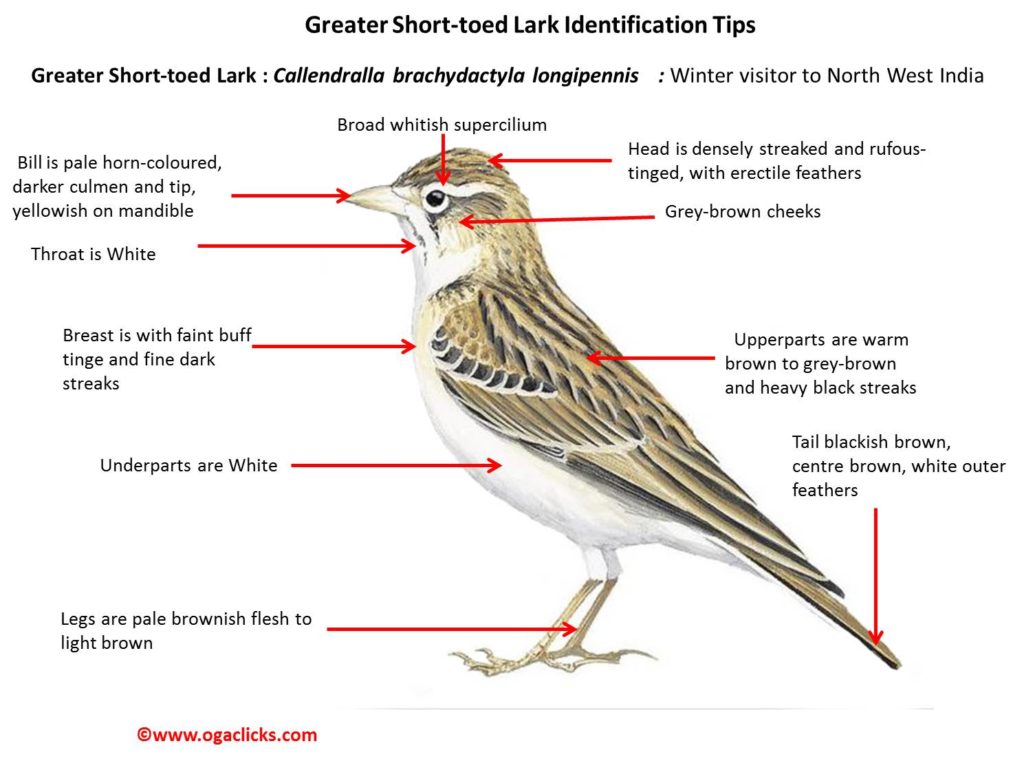
Greater Short-toed Lark Callendralla brachydactyla longipennis
Etymology:
- Calandrella : Greek word for Lark derived from kalandros – Calandra Lark
- Brachydactyla : Greek word brakhus –short; daktulos – toe { Short toed}
- Longipennis : Latin word longus – long ; pennis -winged, feathered { Long feathered}
Vernacular Names: Hindi: Bagheri ka Pullak, Bi: Akonia, Guj: Pulak, Sadu chandul, Mar: Akhud Botancha chandol
Distribution in India: Widespread winter visitor in North, West, Central and South West costal India
Description: Size of 12-14 cm. It is a small, neat, pale, short-billed lark with long tertials almost cloaking tips of folded wings, narrow and pointed outer primary strongly reduced shortish tail; straight hind claw. The nominate race has broad whitish supercilium, grey-brown cheeks. They are warm brown to grey-brown and heavily streaked blackish above, top of head usually densely streaked and often rufous-tinged, with erectile feathers; median coverts with dark centres and buff fringes, contrast with rest of upperwing. The tail is blackish-brown, centre brown, white outer feathers; throat and underparts whitish, small blackish patch on lower neck side, breast side with faint buff tinge and fine dark streaks ; undertail blackish . The bill is pale horn-coloured, darker culmen and tip, yellowish on lower mandible. The legs are pale brownish-flesh to light brown. Both the sexes are similar.
Habitat: It is found in dry areas with sparse and low vegetation cover, on level or undulating terrain, with sandy or stony soils. It breeds mostly in fallow lands in Mediterranean Basin, but also dry pastures, tobacco fields, dirt tracks and olive groves. During non-breeding time occurs in semi-arid areas and farmland.
Food habits: It eats invertebrates like beetles, ants, bugs and snails. During spring, it eats seeds and green parts of plants in other seasons. The nestlings fed solely with invertebrates; and only when they fledge they eat green material .It forages on ground, singly or in small or large flocks ,searches slowly and picks items from ground surface.
Breeding habits: They breed in May–Jul in SW Europe, Apr in SE Europe Africa and Israel. The mating display by male is male song, undulating and bouncing in a circling but rather meandering path. The nest is built by female, of grasses, rootlets and similar vegetation, lined with softer material, , placed in shallow scrape on ground, usually beside shrub or grass tuft, often with small rampart of sticks or stones. They lay a clutch of 2–5 eggs; replacement laid if first clutch lost. The incubation is done by female alone, beginning with last or penultimate egg. The incubation period is 11–13 days. The chicks are fed and cared for by both sexes. The nestling period is 9–12 days and, fledging period is 12–15 days and dependence period of fledglings is 1–3 weeks.